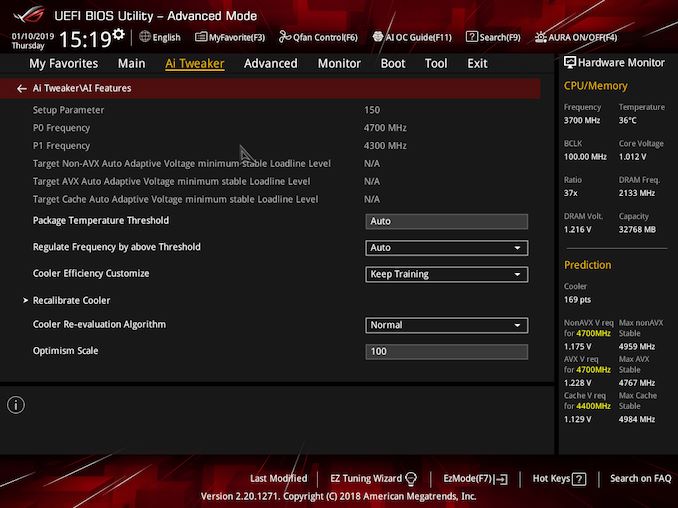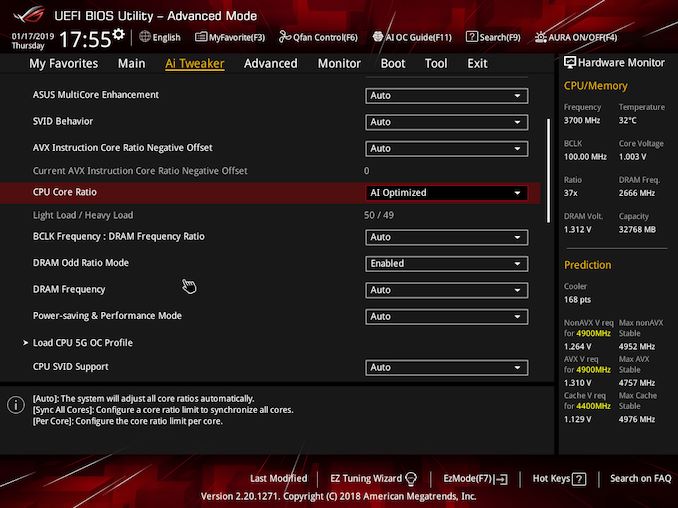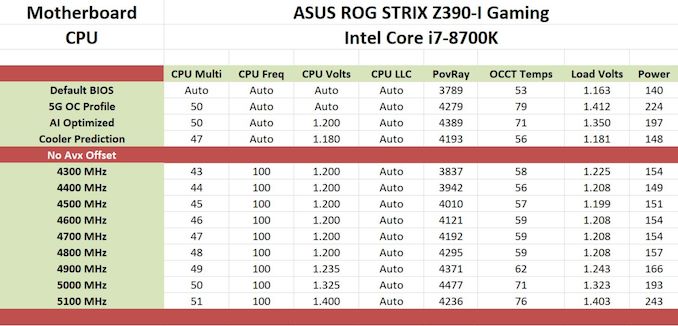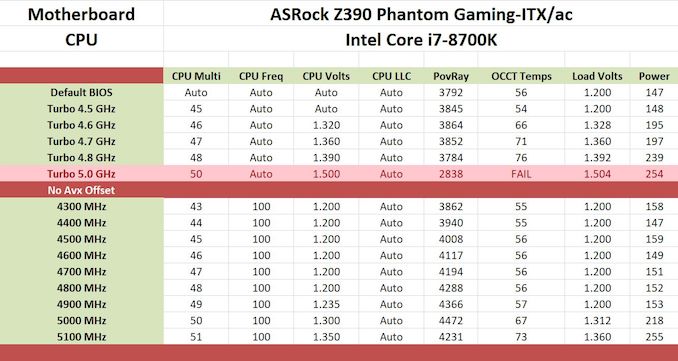Tiny at $200: ASUS Z390-I Gaming vs. ASRock Z390 Gaming-ITX/ac Review
by Gavin Bonshor on February 12, 2019 10:00 AM ESTOverclocking
Experience with the ASUS ROG Strix Z390-I Gaming
Our Z390 test bed Core i7-8700K processor might not be the highest-grade silicon around, but we do know it has limitations of 5.1 GHz on every board we’ve tested so far. It’s a somewhat dirty chip that likes to draw power and run hot, which makes running 5.1 GHz somewhat fruitless with good ambient cooling due to thermal throttling.
Overclocking on the ASUS ROG Strix Z390-I Gaming can be approached multiple ways; some simple, some intuitive and everything in between. One of the most alluring features within the BIOS comes via the Cooler Predictor inside the Ai Tweaker. What this does is calibrates the firmware to output a score based on the cooler that’s installed which then, in turn, outputs the blueprint for what it thinks is an achievable overclock. The option is there to recalibrate if you believe the firmware has it wrong, or the optimism scale can be edited a bit higher for slightly looser regulation to boost the score; this could lead to unstable overclocks as it’s essentially being told to take what it thinks and either add extra frequency and more CPU VCore to that.
Applying the predefined 5.0 GHz overclock can be done by simply selecting it from the Ai Overclock Tuner drop-down menu and selecting the profile. ASUS also offers an AI Optimized profile based on unknown criteria by the firmware. Manually overclocking the Strix Z390-I Gaming is as simple to do as it is on any other board of good quality. Users can change both the CPU and Cache ratio in 100 MHz increments e.g. x45, 46; altering the base clock is also possible but this does also overclock the IO and memory in addition to CPU core frequency. The CPU VCore and Cache voltages are linked and the ASUS ROG UEFI BIOS offers many voltages for voltages, eight different load line calibration settings for VDroop and provides many settings for overclocking memory.
Experience with the ASRock Z390 Phantom Gaming-ITX/ac
What you see is what you get with the ASRock Phantom Gaming UEFI BIOS, a simple and well laid out set of settings and options. For overclocking specifically, all of the overclocking options are presented in the OC Tweaker section, with options for CPU and Cache frequency, memory configuration and voltage controls all with their own individual sections. This is a positive and a negative in that when overclocking all the components at the same time (not recommended), bouncing around to different parts of the firmware could lead to confusion for users who aren’t as experienced. Having the primary settings such as CPU ratio, CPU VCore, DRAM frequency and relevant voltages on the same page can save time as all the information is in front of you. That being said, in each of the sections all the options and more are there for use and for memory overclocking, the BIOS holds extensive memory tweaking options.
Loading up one of the five ASRock preset overclocks which include 4.5 to 5 GHz with the exception of 4.9 GHz, can be done with the aptly named Load Optimized CPU OC Setting drop-down menu. There are profiles for extreme overclockers which can be accessed by loading the Ln2 Overclocking preset and for owners of DDR4 using Samsung’s B-Die ICs, a profile for running tighter latency timings can be enabled. The primary differences between the normal and extreme voltage mode are it lifts restrictions on the CPU Vcore. At default the CPU Vcore limit maxes out at 1.52 V, whereas the limit is lifted and allows users to apply 2.0 V; extreme in this case means extreme overclocking and any user applying 2.0 V to their CPU would most certainly damage and at the very least, degrade the silicon quality.
The ASRock Phantom Gaming firmware is certainly well-equipped for overclocking and there’s plenty of useful options to go through and customize. The 5+2 power delivery is using some of the best power stages in the Intersil 99227’s and the VCore section heatsink certainly seems up to the task.
Overclocking Methodology
Our standard overclocking methodology is as follows. We select the automatic overclock options and test for stability with POV-Ray and OCCT to simulate high-end workloads. These stability tests aim to catch any immediate causes for memory or CPU errors.
For manual overclocks, based on the information gathered from the previous testing, starts off at a nominal voltage and CPU multiplier, and the multiplier is increased until the stability tests are failed. The CPU voltage is increased gradually until the stability tests are passed, and the process repeated until the motherboard reduces the multiplier automatically (due to safety protocol) or the CPU temperature reaches a stupidly high level (90ºC+). Our test bed is not in a case, which should push overclocks higher with fresher (cooler) air.
Overclocking Results
ASUS ROG Strix Z390-I Gaming
So far from the models we've tested, the ASUS ROG Strix Z390-I Gaming has one of the best 5.0 GHz profiles on Z390. At full load in our test suite, the maximum CPU VCore under load hit 1.412 V; this is good compared to other vendors/models that think 1.50 V is an acceptable level for users to apply to their processors. The AI Optimized profile proved the best profile of the bunch and was really surprised at how efficient it can be; ROG are well known in the overclocking circuit and the ASUS engineers clearly have a knack for this sort of thing. With the AI Optimized profile, the board achieved an automatic overclock of 5.0 GHz with an applied CPU VCore of 1.20 V in the BIOS, but would jump up to 1.35 V at full load; with 27 W less power draw and running 8°c cooler than the 5.0 GHz profile.
The results when manually overclocking also show that ASUS has a lower threshold for thermal throttling with good and consistent performance in POV-Ray. Performance only started to drop off slightly at 5.1 GHz with 1.403 V at load. The VDroop throughout the CPU ratios was tight and only ever so slightly undercut itself at 5.0 GHz; 1.325 V applied in the BIOS and 1.323 V at full load. The settings supplied by the Ai Tweaker's Cooler Prediction also worked well with a 100% stable overclock of 4.7 GHz at 1.180 V on the CPU VCore; it's an ingenious function and aims to take away some of the hard work of overclocking. Overclocking is fun, but to me it is and while squeezing every last bit of performance out without overzealously trying to compensate stability for too much VCore which as a result, does increase temperature and power draw.
ASUS has a tendency to cater for the art of overclocking well on their mid-range to high-end desktop motherboards and outside of the specific overclocking focused boards such as the ROG Maximus XI Apex and ROG Maximus XI Gene, the Strix Z390-I Gaming certainly delivers great overclocking performance with ambient cooling methods. The dismay of the supposed 6-phase which really translates into a 3-phase on the CPU section of the power delivery isn’t noticeable here and doesn’t detract anything from the actual performance.
ASRock Z390 Phantom Gaming-ITX/ac
Overclocking on the ASRock Z390 Phantom Gaming-ITX/ac was without fanfare and the most notable conclusion to draw from it was managing to achieve an overclock of 5.1 GHz at just 1.35 V; for reference, we needed 1.40 V on the ASUS ROG Strix Z390-I Gaming. Temperatures didn’t escalate above extreme levels, but we did incur some thermal throttling above 70°c. Using the five overclocking presets already loaded in from the firmware, the only reasonable settings came with the Turbo 4.5 GHz which used a maximum of 1.20 V on the VCore to achieve this at load. The other settings put more than 1.30 V on the VCore which for an overclock of 4.6 GHz and beyond, is just too much for what every Core i7-8700K should have the potential to achieve. On the 5.0 GHz profile, the Z390 Phantom Gaming-ITX/ac applied 1.50 V on the CPU VCore which not only throttled back massively due to the temperatures but went above and beyond the 85°C temperature limit on our OCCT stress test.
Applying manual overclocks with the ASRock Z390 Phantom Gaming-ITX/ac was painless and for users familiar with the layout of the firmware, will certainly appreciate the amount of fine-tuning that can be achieved. Performance in our POV-Ray benchmark proved consistent until thermal throttling became an issue at 5.1 GHz with 1.35 V and a power draw of 255 W at the wall.
The board has a very solid 5+2 power delivery which puts many ATX models in the same price range to shame quality wise; with the extreme settings, this mini-ITX motherboard would be more than ample for some extreme overclocking, not to mention the included support for DDR4-4500 memory out of the box.















26 Comments
View All Comments
Marlin1975 - Tuesday, February 12, 2019 - link
Great review, thanks.Cheaper and seems better overall, ASRock for the win.
goatfajitas - Tuesday, February 12, 2019 - link
Isnt ASRock just the lower end brandname from Asus? Same basic parts.LiquidSilverZ - Tuesday, February 12, 2019 - link
No, they are a separate brand.Korguz - Tuesday, February 12, 2019 - link
desperate brand.. that was a spin off of Asus to compete in the OEM market in 2002, and has since expanded into the non oem market :-)goatfajitas - Tuesday, February 12, 2019 - link
Separate brand, yes. Same company though. Like Honda/Acura or Toyota/Lexus.jeremyshaw - Tuesday, February 12, 2019 - link
Nah, ASUS gave up ownership years ago.goatfajitas - Tuesday, February 12, 2019 - link
Did they? I wasn't aware. Still likely use alot of the same parts from the same sources. For example, the similar parts above.eva02langley - Tuesday, February 12, 2019 - link
Same company pal...Korguz - Wednesday, February 13, 2019 - link
asus and asrock are seperate companies, owned by different owners, ASrock, is owned by pegatron.FSWKU - Wednesday, February 13, 2019 - link
Who Asus still farms their warranty repairs out to (along with Atan Gtech)